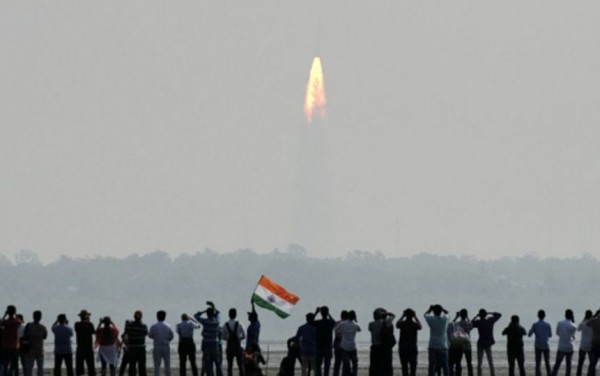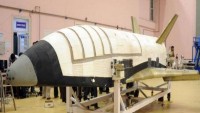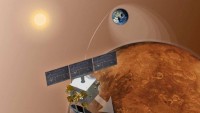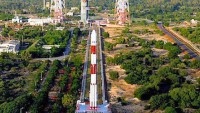India Makes Space History; Orbits 104 Satellites in One Mission
| Arthur Dominic Villasanta | | Feb 15, 2017 07:49 AM EST |
(Photo : ISRO) PSLV-C37 blasts-off with a payload of 104 nanosatellites.
India was awash in national pride at the historic news it had launched 104 small satellites into low Earth orbit (LEO) -- the largest number of satellites ever orbited on one mission by any country.
A Polar Satellite Launch Vehicle (PSLV), the workhorse launch vehicle of India's space program, at 9:28 a.m. on Feb. 15 blasted-off from the Satish Dhawan Space Center on the island of Sriharikota to successfully place 104 nanosatellites into LEO.
Like Us on Facebook
The tiny satellites began being ejected into their prescribed orbits 17 minutes after the flight, PSLV-C37, reached LEO. The Indian Space Research Organization (ISRO), India's equivalent of NASA, said it took only 10 minutes to launch all the nanosatellites into space.
A nanosatellite, also called a cube satellite or CubeSat, is defined as a small satellite with a wet mass between 1 kg and 10 kg. Because of their puny size, nanosatellites are infinitely cheaper than ordinary satellites and infinitely easier to build. Even college students have built nanosatellites.
It was PSLV's 39th mission since its maiden flight, PSLV-D1, lifted-off on Sept. 20, 1993. Of these missions, 37 were successful.
Of the 104 satellites placed into orbit, 101 satellites belonged to six foreign countries. They included 96 from the U.S. and one each from Israel, the UAE, the Netherlands, Switzerland and Kazakhstan.
The PSLV XL launch vehicle first injected into orbit its main payload, Cartosat-2, India's indigenously built earth observation satellite. Cartosat-2 was followed into space by two other ISRO nanosatellites -- INS-1A and INS-1B.
The other satellites orbited were United Arab Emirates Nayif-1 CubeSats; Kazakhstan Al Farabi-1; Netherland's PEASSS; Israel's BGUSat; Switzerland's DIDO-2; United States' Doves (Flock 3p) and United States' LEMUR Nano.
Indian Prime Minister Narendra Modi praised ISRO scientists for the successful launch. ISRO chief A S Kiran Kumar said Modi congratulated the ISRO team for the successful launch.
"Congratulations to @isro for the successful launch of PSLV-C37 and CARTOSAT satellite together with 103 nano satellites!" tweeted Modi.
"This remarkable feat by @isro is yet another proud moment for our space scientific community and the nation. India salutes our scientists," he said.
TagsIndia, 104 nanosatellites, low-earth orbit, Satish Dhawan Space Cente, PSLV-C37, Indian Space Research Organization, ISRO, nanosatellite, cube satellite, CubeSat, Prime Minister Narendra Modi
©2015 Chinatopix All rights reserved. Do not reproduce without permission
EDITOR'S PICKS
-

Did the Trump administration just announce plans for a trade war with ‘hostile’ China and Russia?
-

US Senate passes Taiwan travel bill slammed by China
-

As Yan Sihong’s family grieves, here are other Chinese students who went missing abroad. Some have never been found
-

Beijing blasts Western critics who ‘smear China’ with the term sharp power
-

China Envoy Seeks to Defuse Tensions With U.S. as a Trade War Brews
-

Singapore's Deputy PM Provides Bitcoin Vote of Confidence Amid China's Blanket Bans
-

China warns investors over risks in overseas virtual currency trading
-

Chinese government most trustworthy: survey
-

Kashima Antlers On Course For Back-To-Back Titles
MOST POPULAR
LATEST NEWS
Zhou Yongkang: China's Former Security Chief Sentenced to Life in Prison

China's former Chief of the Ministry of Public Security, Zhou Yongkang, has been given a life sentence after he was found guilty of abusing his office, bribery and deliberately ... Full Article
TRENDING STORY

China Pork Prices Expected to Stabilize As The Supplies Recover

Elephone P9000 Smartphone is now on Sale on Amazon India

There's a Big Chance Cliffhangers Won't Still Be Resolved When Grey's Anatomy Season 13 Returns

Supreme Court Ruled on Samsung vs Apple Dispute for Patent Infringement

Microsoft Surface Pro 5 Rumors and Release Date: What is the Latest?













